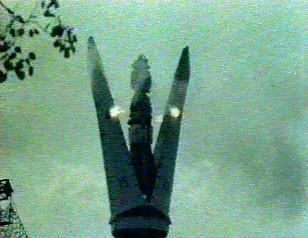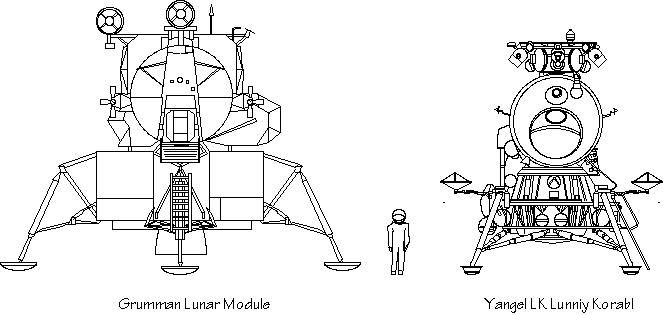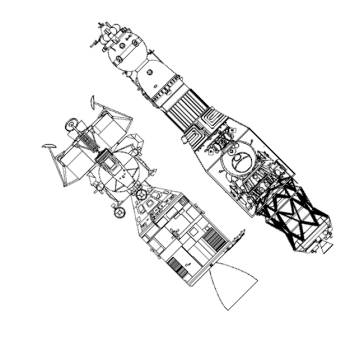New Mars Forums
You are not logged in.
- Topics: Active | Unanswered
Announcement
Pages: 1
#1 2016-03-27 08:55:17
- Tom Kalbfus
- Banned
- Registered: 2006-08-16
- Posts: 4,401
Soviet Moon Landing
I saw this interesting simulation of a soviet Moon Landing.
https://www.youtube.com/watch?v=55VeMPrzDRc
Interesting how they need a space walk to transfer one astronaut from the Command Module to the Lunar Lander.
Offline
Like button can go here
#2 2016-03-27 10:22:01
- RobertDyck
- Moderator
- From: Winnipeg, Canada
- Registered: 2002-08-20
- Posts: 8,299
- Website
Re: Soviet Moon Landing
Interesting video. I certainly can't make a video. However, this video gets a few things wrong. In 1989, Russian President Boris Yeltsin released documents about the Soviet space program. One guy from Austria, Mark Wade, compiled a website as an encyclopedia of every space program in the world, from the NAZI V2 through proposals that were never built. He was part of a group of people from Western Europe who reached out to Russia to make friends when the Soviet Union broke up. Mark Wade got a copy of every Soviet space document the Russians declassified.
Encyclopedia Astronautic: LK
The acronym stands for "Lunniy Korabl" - Russian for Lunar Craft.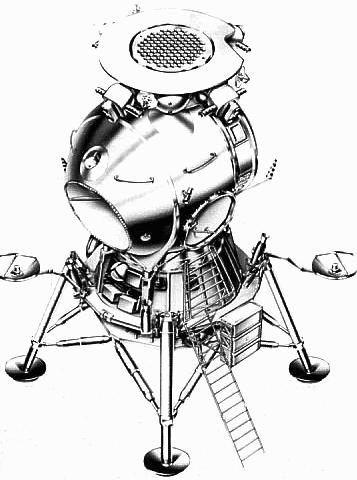
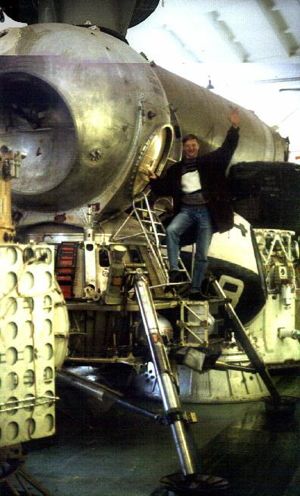
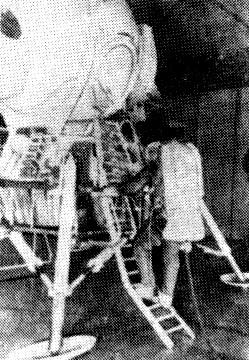
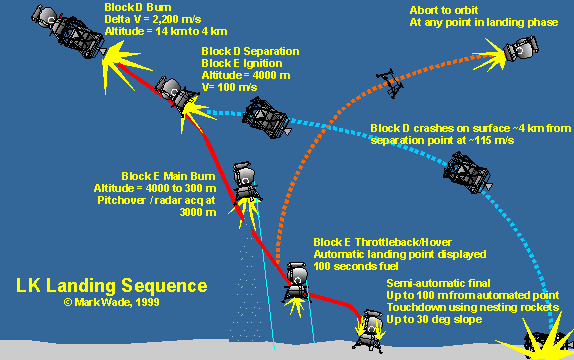
During landing, the LK has nesting rockets. That's used to ensure the LK doesn't bounce on landing. Nesting rockets are necessary for an asteroid, but really not needed for the Moon. However, they used them. The video doesn't show that. The video appears to show the nesting rockets as tubes that slide along poles attached to the legs. The LK didn't have anything like that.
The video also shows the LK stop close to the Soyuz LOK, then a spacewalk in free space between them. That's not how it worked. Soyuz LOK has a "probe" at its nose, LK had a plate with multiple hexagonal holes. The probe would enter one of the holes then latch on. That formed a hard attachment between craft. The astronaut would then use handles on the outside of both craft, going hand-over-hand from one to the other. He wouldn't at any point float free.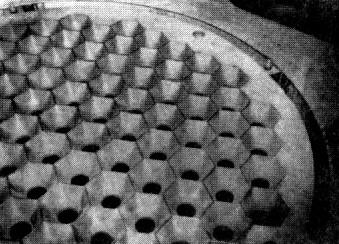
Proportions are a little off. The video shows a small mission module on the Soyuz LOK, smaller than the LOK pressure cabin. They were actually about the same size.
And proportions of the LK to the Block D stage are a bit off as well.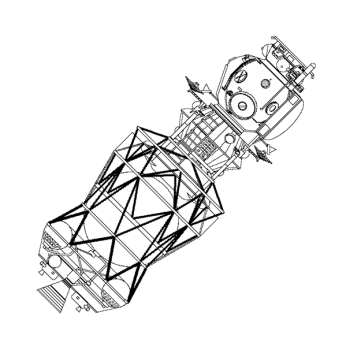
I believe the fairing around LK remained on during TLI and LOI burns. It provided structural support.
In fact, there was a "shroud" that acted as fairing during launch. It encompassed the entire spacecraft stack: Soyuz LOK, LK, Block D stage, and fairing around the LK. So the only reason for the inner fairing was structural.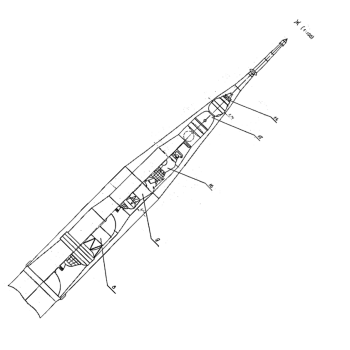
Wikipedia has a comparison of Saturn V vs N1. And this page has a table showing the jobs of each stage. It has comparison of propellant, thrust, burn time, total impulse, payload. N1 was a direct competitor for Saturn V. However, one Soviet government official took the money to build the test stand for the big first stage of N1, and used it for something else. They had test stands for all other stages, but not the big first stage. That meant they had to launch without engineers testing that stage. The result was the stage blew up during launch, twice.
At first I thought the video shows the first two stages launching into orbit. The third stage was for Earth orbit insertion. Saturn V used its third stage, called S-IVB, for two jobs: Earth orbit insertion, and TLI. N1 used its third stage, called Block V, for Earth orbit insertion. TLI was done with a dedicated stage, called Block G. The video shows the launch abort rocket and Block G falling off in orbit, with no apparent use. However, looking more closely it does. However, it shows an open mess support between Block G and Block D, like supports on top of the first two stages. But I believe the shroud covered that.
The video shows a close fairing, similar to Apollo-Saturn V. And shows the fairing discarding during TLI burn. But the shroud was smooth, and discarded during launch into orbit. And again, the inner fairing is not shown. The video makes it look like the LK docking grid plate was used for support during thrust. But the inner fairing was for that.
The video shows diamonds in rocket exhaust during TLI burn, and all in-space burns. That is caused when supersonic exhaust interacts with atmosphere. The exhaust doesn't mix with static or subsonic air, and shock waves bounce off the boundary layer between supersonic gas flow and air. Those shock waves produce the diamonds. Space doesn't have air, so there is no boundary layer, so no diamonds.
The video also shows Soyuz LOK entering Earth orbit with propulsion. It used direct entry, like Apollo.
I could be even more nitpicky, and point out the parachute did not have a cut-out ring. And parachute cords gathered to a single support, which then separated to cords that then attach to the capsule, they didn't individually attach. 
Interesting, this graphic shows the heat shield is jettisoned to reveal landing rockets on the bottom. I thought rockets on parachute cords pulled up.
Last edited by RobertDyck (2016-03-28 17:07:23)
Offline
Like button can go here
#3 2016-03-27 10:44:39
- SpaceNut
- Administrator
- From: New Hampshire
- Registered: 2004-07-22
- Posts: 29,932
Re: Soviet Moon Landing
Let the space race begin anew, again Russian, China lets go....maybe that will goud the USA into getting off its funding as* and put forth some real effort... but lets not make this a sortie mission just to say we can do it. Lets make it so much more to stay......
Offline
Like button can go here
#4 2016-03-27 13:47:41
- RobertDyck
- Moderator
- From: Winnipeg, Canada
- Registered: 2002-08-20
- Posts: 8,299
- Website
Re: Soviet Moon Landing
Makes me wonder. Energia was based on Vulkan, but modified to carry Burya space shuttle orbiters. The first orbiter was named Buran. Vulkan would have had an 8 metre diameter core stage, and 4 RD-0120 engines. Core stage of Energia was 7.75 metre diameter, with 4 RD-0120 engines. Vulkan was said to have 6 strap-on boosters, each a first stage of a Zenit rocket. Energia had 4 boosters, and an empty side to mount the orbiter. Vulkan was to have an upper stage with the same diameter as the core. Energia had an optional upper stage that mounted on the side instead of the orbiter. What if?
What if a new launch vehicle was developed based on Energia? Using the same core stage as Energia, with 7.75 metre diameter. But instead of a pointy top, a "flat" top. That's actually a domed top to the LOX tank, with a metal cylinder that extends as high as the top of the tank, just like the core stage of SLS. Then use 6 strap-on boosters, like Vulkan. And an upper stage with 7.75 meter diameter, and a single RD-75M engine. The upper stage of Vulkan was to have an 8 metre diameter to match the Vulkan core stage, but this one would be for the modified Energia.
Could that throw a Soyuz LOK with LK and Block D to TLI? So upgraded Energia instead of N1? The "building of assembly and test" (MIK) and launch pads for N1 were converted for Energia. Block DM was the updated version of Block D, a little longer to hold more propellant. There were 3 versions: DM-2 (built 1982-2001), DM-2M (built 1994-2002), and DM-5 (built 1997-2002).
Race to the Moon, as SpaceNut said? There is a market for commercial passengers, some billionaires would pay big bucks for a tourist trip to the surface of the Moon. Russia has demonstrated they're willing to take cash from billionaires. Of course Energia was launched from the Baikonur Cosmodrome in Kazakhstan, core module tanks built in Russia but transported to the launch site via AN-225 aircraft built in Kiev, and strap-on boosters built in Dnipropetrovsk in east Ukraine. So resurrecting Energia requires all those to work together. But I see that cooperation as part of the objective. My greatest concern is that this would be the Moon, not Mars.
RD-57A-1
Lyulka lox/lh2 rocket engine. 395 kN. Developed 1995-98. Isp=460s. New version of RD-57M for SSTO-demonstrator proposed by Aerojet. Optimized nozzle contour for performance increase, new chamber material for weight reduction.First launch was planned for 3rd quarter 1998 in 1994, but not performed until 1999.
Last edited by RobertDyck (2016-03-27 21:31:10)
Offline
Like button can go here
#5 2016-03-27 18:34:46
- SpaceNut
- Administrator
- From: New Hampshire
- Registered: 2004-07-22
- Posts: 29,932
Re: Soviet Moon Landing
So how do we drive the commercial market to get going when even a google prize for robotic landing does not seem to be enough to do the job....
Even when we consider orbital assembly and using existing rockets we still need a company or 2 to design a moon lander. Space X is close but there is the need for a design modificationof what they have to make such a mission happen with just there hardware. Boeing will have the CST-100 soon but just like Space x there is still the same need as a commercial provider even if they use lockheeds launcher or there own Delta IV in any of the paper designs. Lockheed as a company could do more with Orion if they wanted to build there own out of there money plus they do have the Seirra Nevada groups Dreamchaser that could be modified for orbital use but there is still the nagging lunar lander for all....Orbital ATK do have the launcher plus cargo module that could serve as a habitat but what would they use as a capsule and then there is the lander still...
When will these companies cross the line into providers versus contractors....
Offline
Like button can go here
#6 2016-03-27 21:57:03
- RobertDyck
- Moderator
- From: Winnipeg, Canada
- Registered: 2002-08-20
- Posts: 8,299
- Website
Re: Soviet Moon Landing
I don't see that they will. Boeing and Lockheed are in the business of building stuff, not operating stuff. Virgin Galactic was in the business of operating a space tourism company, Scaled Composites was to build the vehicle for them. But they had a problem, their vehicle didn't work. They demonstrated SpaceShipOne to win the X-Prize, but when they tried to scale it up to SpaceShipTwo, they had several problems. Their engine had stability problems, they tried to change the fuel, then tried to push forward. Their last test ended with a crash, one pilot died. It's a miracle the other lived, no ejection seat and no parachute. They invested in building Space Port America, but not a single flight has flown to space there. Given that track record, why would a commercial company invest in space?
Owners of commercial companies are relatively cautious. They're willing to invest in some speculative ventures, but the financial investment required for space is just too much. They would be willing if the money was much MUCH smaller, or if Return-On-Investment was guaranteed. But high risk and high stakes, both at the same time? Let me use a metaphor for how commercial industry sees this: play Russian roulette with a rocket propelled grenade aimed at your head.
The founder and CEO of Amazon.com has a lot of money to blow. He established Blue Origin, and demonstrated New Shepard. It's only suborbital, but it is reusable. That will help, but even that isn't enough. If Virgin Galactic also gets their act together, the two companies together will demonstrate to the rest of commercial industry that it can be done.
Offline
Like button can go here
#7 2016-03-27 22:11:44
- RobertDyck
- Moderator
- From: Winnipeg, Canada
- Registered: 2002-08-20
- Posts: 8,299
- Website
Re: Soviet Moon Landing
Notice what I did with post #4, it uses existing equipment. No risk. Energia was the most tested launch vehicle in history, period. The reason was N1 was not sufficiently tested, so it failed. Russia didn't want to make that mistake again, so they went to extremes testing Energia. The Buran space shuttle orbiter did fly once, unmanned on autopilot only, but it did fly. It worked perfectly. Then the head of the Russian space shuttle program was part of the attempted military coup against President Boris Yeltsin. The last report on the internet said he was sent to a gulag in Siberia. The space shuttle program was mothballed. But Energia worked. Vulkan was under development until it became Energia, Vulkan was supposed to be flexible. It was actually supposed to able to launch with none, 2, 4, 6, or 8 boosters. Each booster being the first stage of a Zenit launch vehicle. My attempts to determine the status of Energia facilities showed it could have been, until the roof collapsed in 2002. Google Maps shows the roof of one of the high bays of the vehicle assembly building has been repaired, the one used to stage modules for ISS. So the building could be repaired. The engine for the upper stage of Vulkan was developed further for Aerojet. The stage for the Soviet L3 stack used for Lunar orbit insertion and de-orbit of LK, was Block D. That was upgraded to Block DM, which was in production through 2002. Soyuz is still flying, used to carry cosmonauts and astronauts to ISS. The service module would have to be expanded for more propellant, but that's all. An option for Soyuz today is life support for 3 cosmonauts for 14 days, a lunar mission would require life support for 2 astronauts for 14 days. The LK would have to be modified to have a docking hatch compatible with the modern Soyuz instead of the capture plate of the 1960s. The current rendezvous and docking system of Soyuz could be used for a Lunar mission. You would want to expand the LK to carry both astronauts, and Soyuz would have to operate unattended in Lunar orbit while astronauts are on the lunar surface, but Russian engineers design stuff to be even more automated than NASA stuff, so that shouldn't be a problem.
This mission plan to go to the Moon is very low risk. That's the kind of thing commercial industry needs. Even at that, I don't see commercial industry getting involved until AFTER Russia demonstrates one successful mission.
Offline
Like button can go here
#8 2016-03-28 02:06:45
- Tom Kalbfus
- Banned
- Registered: 2006-08-16
- Posts: 4,401
Re: Soviet Moon Landing
Notice what I did with post #4, it uses existing equipment. No risk. Energia was the most tested launch vehicle in history, period. The reason was N1 was not sufficiently tested, so it failed. Russia didn't want to make that mistake again, so they went to extremes testing Energia. The Buran space shuttle orbiter did fly once, unmanned on autopilot only, but it did fly. It worked perfectly. Then the head of the Russian space shuttle program was part of the attempted military coup against President Boris Yeltsin.
I believe the attempted Military coup was against Mikhail Gorbachev, Boris Yeltsin was simply the beneficiary of its failure. Communism failed the Russian Space Program, it couldn't create the economic growth required to support the space program, any level-headed military officer should have recognized its failure and concluded that it just wouldn't work instead of supporting it further. Karl Marx didn't know squat about how economics worked.
The last report on the internet said he was sent to a gulag in Siberia. The space shuttle program was mothballed. But Energia worked. Vulkan was under development until it became Energia, Vulkan was supposed to be flexible. It was actually supposed to able to launch with none, 2, 4, 6, or 8 boosters. Each booster being the first stage of a Zenit launch vehicle. My attempts to determine the status of Energia facilities showed it could have been, until the roof collapsed in 2002. Google Maps shows the roof of one of the high bays of the vehicle assembly building has been repaired, the one used to stage modules for ISS. So the building could be repaired. The engine for the upper stage of Vulkan was developed further for Aerojet. The stage for the Soviet L3 stack used for Lunar orbit insertion and de-orbit of LK, was Block D. That was upgraded to Block DM, which was in production through 2002. Soyuz is still flying, used to carry cosmonauts and astronauts to ISS. The service module would have to be expanded for more propellant, but that's all. An option for Soyuz today is life support for 3 cosmonauts for 14 days, a lunar mission would require life support for 2 astronauts for 14 days. The LK would have to be modified to have a docking hatch compatible with the modern Soyuz instead of the capture plate of the 1960s. The current rendezvous and docking system of Soyuz could be used for a Lunar mission. You would want to expand the LK to carry both astronauts, and Soyuz would have to operate unattended in Lunar orbit while astronauts are on the lunar surface, but Russian engineers design stuff to be even more automated than NASA stuff, so that shouldn't be a problem.
This mission plan to go to the Moon is very low risk. That's the kind of thing commercial industry needs. Even at that, I don't see commercial industry getting involved until AFTER Russia demonstrates one successful mission.
I imagine SpaceX could do it, and it wouldn't let Politics get in the way, or a Cold War following some unworkable social utopian dream.
Offline
Like button can go here
#9 2016-03-28 09:58:03
- RobertDyck
- Moderator
- From: Winnipeg, Canada
- Registered: 2002-08-20
- Posts: 8,299
- Website
Re: Soviet Moon Landing
I believe the attempted Military coup was against Mikhail Gorbachev, Boris Yeltsin was simply the beneficiary of its failure. Communism failed the Russian Space Program, it couldn't create the economic growth required to support the space program, any level-headed military officer should have recognized its failure and concluded that it just wouldn't work instead of supporting it further. Karl Marx didn't know squat about how economics worked.
Don't try to rewrite history. Mikhail Gorbachev really believed in communism, felt treating other Soviet citizens with respect meant they didn't have to threaten military action just to keep their country together. Perestroika and Glasnost was about making the Soviet Union one country, and reducing military expenditure just to maintain their country. But it was too late, there were major parts that resented harsh action by past leaders. When no longer threatened with military action, they left. Boris Yeltsin saw this reality, worked with it instead of trying to fight it, and tried to end the Cold War by reaching out to the West. Certain individuals from the former Soviet government wanted communism back, and they wanted to reunify the Soviet Union. They attempted military action to remove Boris Yeltsin. It failed. They paid dearly.
Offline
Like button can go here
#10 2016-03-28 15:57:07
- Terraformer
- Member
- From: The Fortunate Isles
- Registered: 2007-08-27
- Posts: 3,988
- Website
Re: Soviet Moon Landing
Tom, please, not every discussion has to become a political discussion. Keep it in the right thread,
Use what is abundant and build to last
Offline
Like button can go here
#11 2016-03-28 16:56:49
- SpaceNut
- Administrator
- From: New Hampshire
- Registered: 2004-07-22
- Posts: 29,932
Re: Soviet Moon Landing
Thanks Terraformer.... The Russian could of would have should have is behind them and it appears far from being able to resurect....
The only rocket flying in Europe is Ariane_5 which is slated for upgrade or replacement by the Ariane_6 under development by the European Space Agency (ESA), with a first test flight scheduled for 2020.
As of November 2014, the Ariane 5 commercial launch price for launching a "midsize satellite in the lower position" is approximately US$60 million, competing for commercial launches in an increasingly competitive market, mainly due to SpaceX.
With a very good track rate of success.
Offline
Like button can go here
#12 2016-03-28 17:42:00
- RobertDyck
- Moderator
- From: Winnipeg, Canada
- Registered: 2002-08-20
- Posts: 8,299
- Website
Re: Soviet Moon Landing
This discussions started with a video of the Soviet Moon landing. In fact that's the title. Besides, America is in search of a lunar module. Altair never went beyond a proposal for Constellation, and it's way too big/heavy. The Soviet LK was much more compact. Could you add LK to Orion launched on SLS block 2B? A single launch like Apollo? Somehow I see some Congressmen having a cow over that.
This would be ironic considering the Orion service module only has enough propellant for Lunar orbit departure, aka TEI. It doesn't have propellant for Lunar Orbit Insertion. Orion keeps the SLS upper stage attached all the way to the Moon, so that stage can be used for LOI. That's what the Soviets did with their Block D.
Lets see... SLS block 2B: core stage with 4 SSME, Exploration Upper Stage, and liquid boosters with F-1B engines. That can throw 52.3 metric tonnes to Trans-Lunar Trajectory. Saturn V could throw 47 metric tonnes to that. But the SLS upper stage has to reserve some propellant for LOI. Orion total mass is 25,848kg including capsule, ATV-based service module, and propellant. LK had a gross mass of 5,560kg, including propellant. SLS block 1B will be able to throw 39.2 metric tonnes to TLI. Hmm...
Last edited by RobertDyck (2016-03-29 09:49:41)
Offline
Like button can go here
#13 2016-03-28 17:58:30
- SpaceNut
- Administrator
- From: New Hampshire
- Registered: 2004-07-22
- Posts: 29,932
Re: Soviet Moon Landing
I sure can see the congress seeing red on the Russian LK but then again Nasa keeps quandering its chances to get to the moon....going to find the LM topic to continue my post in.... SLS Rocket + Orion + Apollo LEM
Offline
Like button can go here
#14 2016-03-29 14:53:28
- RobertDyck
- Moderator
- From: Winnipeg, Canada
- Registered: 2002-08-20
- Posts: 8,299
- Website
Re: Soviet Moon Landing
Looking at the LK again, it had a spherical pressure cabin, while NASA's LM had a cylindrical cabin with an extension in the back. Look at images from post #12 above, diameter of the pressure cabin was actually the same. Here is a cross-section of NASA's LM:
And the Soviet LK. Cylindrical extension on the back is the "instrument unit".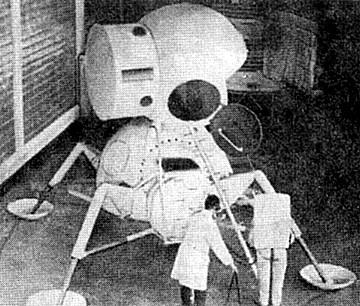
View from inside the pressure cabin, looking back, showing the round door to the instrument unit: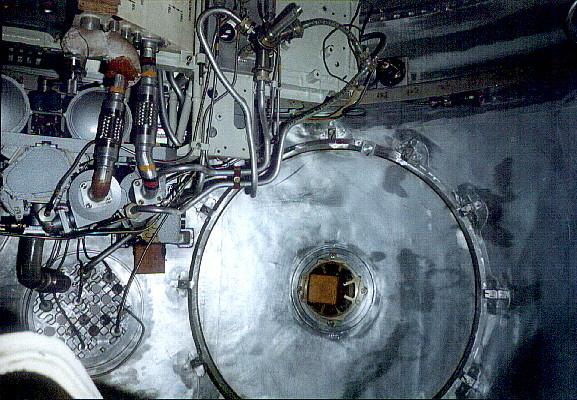
The LM was actually built by a contractor named Grumman, so I supposed I should call it the Grumman LM instead of NASA's, but whatever. The comparison image also shows the name of the Soviet contractor that built the LK, but it's a name I've never heard before.
In any case, the LM had a cover over the ascent stage engine. That took space away from the cabin. The LK used a single propulsion stage for both landing and ascent, so there was no cabin space taken for the engine. Pressure cabin diameter was the same, but total volume of back of the pressured cabin was smaller for the LK. Shouldn't be as a surprise considering the LK was originally intended for a single cosmonaut. I read there were proposals for LK to carry 2 cosmonauts. NASA's LM did not have seats, instead straps on the floor that astronauts would hook their feet into. They stood while landing. Removing seats reduced mass a little, and Lunar gravity is so low that they could. Considering NASA astronauts stood, and the LK has the same diameter, the LK should carry 2 astronauts as well. It's really just a matter of changing windows: 2 windows angled down for landing, instead of just one.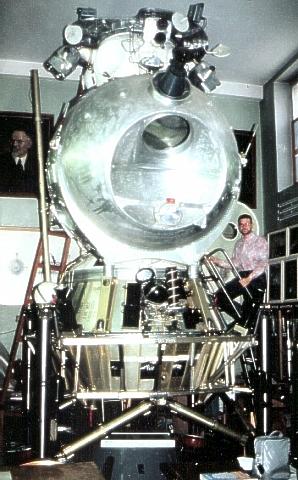
Why am I going on about this? This thread started with a video simulating a Soviet Moon landing. And total mass of the LK is so much lower. It could be used for commercial space tourism, to carry billionaires to the surface of the Moon. Engineering numbers:
LM used by Apollo 9...14: 15,200 kg
LM used by Apollo 15...17: 16,400 kg
LK: 5,560 kg
Offline
Like button can go here
#15 2016-03-29 18:10:38
- Tom Kalbfus
- Banned
- Registered: 2006-08-16
- Posts: 4,401
Re: Soviet Moon Landing
Lack versatility, it can't carry a Moon rover.
Offline
Like button can go here
#16 2016-03-29 22:37:00
- RobertDyck
- Moderator
- From: Winnipeg, Canada
- Registered: 2002-08-20
- Posts: 8,299
- Website
Re: Soviet Moon Landing
Yea, true, no rover. But think about the larger objective. I posted elsewhere about updating the Mars Direct plan. Robert Zubrin talked about using Mars Direct hardware on the Moon. He envisioned sending astronauts in a Mars Direct hab, which would require full-size landing rockets, but no heat shield or parachute. And a Mars Direct ERV, but a single ascent stage instead of two. However, I see a problem with that. The ERV works for Mars because it lands with propellant tanks empty. You make propellant via ISPP. But the Moon has no CO2 atmosphere for ISPP, so you have to land the ERV with full propellant tanks. That means landing an Earth return capsule on the Moon, with propulsive landing, and enough launch propellant to return to the Earth. NASA tried to do that for Apollo in the early days, but found even Saturn V was not large enough to launch it. And that's with a capsule sized for 3 astronauts. How could it work now with 4? So using lessons learned from Apollo, replace the ERV with a "mother ship" and lunar module, like Apollo. Since Congress is committed to using Orion for a Moon mission, use Orion in place of the Apollo CSM. Then add a minimal LM to ferry astronauts to the Lunar surface and back. Use a Mars Direct habitat as a Lunar base. So all we need is something to carry astronauts, it doesn't need to carry a rover or any science instruments. And it doesn't need any space to sleep. The Mars Direct hab will have all that.
So here's a question: using modern composites instead of aluminum alloy, and modern electronics, could this new LK carry 4 astronauts and keep total launch mass the same? Even with a docking hatch compatible with Orion, instead of the capture plate?
Remember, the L3 stack not only used the Block D stage to enter Lunar orbit, it was also used to de-orbit the LK. In this scenario, the Exploration Upper Stage would do the same jobs. That also answers another question: disposal. NASA doesn't like to leave stuff in orbit, it could get in the way of future missions. So they would want to de-orbit EUS. This would de-orbit LK at the same time. One reason LK is so much lighter than LM, is that it doesn't have independent de-orbit capability.
Apollo used SM for two jobs: LOI and TEI. Soyuz LOK only had enough propellant for TEI, not LOI. They used Block D for LOI. Orion's ATV-based SM only has enough propellant for TEI, it uses SLS upper stage for LOI. So they're using the Russian plan already. And Saturn V used metal ring interstages, while N1 used open interstages with support members in an "X". Look at the Exploration Upper Stage; it attaches the LOX to fuel tank with an open truss with members in an "X". Since they're already using Russian techniques, why not add a new Lunar craft based on the Soviet LK?
Offline
Like button can go here
#17 2016-03-29 22:47:30
- RobertDyck
- Moderator
- From: Winnipeg, Canada
- Registered: 2002-08-20
- Posts: 8,299
- Website
Re: Soviet Moon Landing
So there's a couple different directions possible: revive Soyuz/LK and launch with Energia to carry tourists to the Moon. Or build a copy of LK for use with Orion for a redo of Apollo. Or design a new craft based on LK but for 4 astronauts, to demonstrate Mars Direct hardware on the Moon.
Offline
Like button can go here
#18 2016-03-30 07:03:36
- Tom Kalbfus
- Banned
- Registered: 2006-08-16
- Posts: 4,401
Re: Soviet Moon Landing
The LK is 1960s technology, I can't believe you are talking about using it in the 21st century. For one thing, we can use robotics to shovel dirt into an oven, bake out the oxygen bound in the rocks, liquefy it and use it as a propellent with a Nerva engine.
Offline
Like button can go here
#19 2016-03-30 09:10:11
- RobertDyck
- Moderator
- From: Winnipeg, Canada
- Registered: 2002-08-20
- Posts: 8,299
- Website
Re: Soviet Moon Landing
The LK is 1960s technology, I can't believe you are talking about using it in the 21st century. For one thing, we can use robotics to shovel dirt into an oven, bake out the oxygen bound in the rocks, liquefy it and use it as a propellent with a Nerva engine.
Oh for Christ's sake! We don't need you repeating lame excuses contractors use to demand billions of dollars to reinvent the wheel. Physics is physics, it's universal, it doesn't change. Escape velocity will always be escape velocity, no matter what century it is. Aluminum is aluminum. Technology to send humans to the Moon is technology to send humans to the Moon. I would rather send humans to Mars, the Moon is "been there, done that". But some people are just obsessed with the Moon. Congress is spending billions of dollars to redo Apollo; that's what SLS and Orion are all about. Orion is not "multipurpose", it's single purpose. It's not good for anything else. So rather than fight it, work with it. When Robert Zubrin and his partner David Baker came up with Mars Direct, they proposed a method of using Mars Direct hardware on the Moon. This would ensure a Moon mission is relevant to Mars. It demonstrates equipment for Mars. I already posted the problem with using the Mars Direct ERV on the Moon, so this allows use of the Mars Direct hab as a Moon base.
Lunar oxygen as propellant for Mars? Robert Zubrin has written about that many times. One problem is NASA has never given up on the "90 Day Report". Congress immediately said "No way in hell!" But some people in NASA have never given it up. As another irony, this idea you just mentioned of using Lunar oxygen for NERVA, is a 1960s idea.
Offline
Like button can go here
#20 2016-03-30 17:13:10
- SpaceNut
- Administrator
- From: New Hampshire
- Registered: 2004-07-22
- Posts: 29,932
Re: Soviet Moon Landing
Composite versus aluminum is a great question that much like inflatebles we know have less mass so would composites.
Aluminum vs Composite Construction
Difference Between Alloy and Composite
With the information we would need to know more about which composite and where it would be used to fully creat a new lander with less mass.
Offline
Like button can go here
#21 2016-03-30 18:24:06
- RobertDyck
- Moderator
- From: Winnipeg, Canada
- Registered: 2002-08-20
- Posts: 8,299
- Website
Re: Soviet Moon Landing
DC-XA used carbon fibre epoxy for its LH2 tank. It used aluminum lithium alloy for LOX, but X-Corp has a fluoropolymer liner for carbon fibre tanks. Carbon burns in LOX. We should be able to use the same carbon fibre for fuel, would we require the fluoropolymer liner for N2O4? And NASA's LM used Aerozine 50 fuel, which is a 50:50 mixture of UDMH and hydrazine. The SM also used Aerozine 50 for it's main engine, but MMH for RCS thrusters. NASA currently prefers MMH; it's safer. The Soviet LK used UDMH and N2O4. So a new American craft based on LK would also use MMH and N2O4.
UDMH density according to Wikipedia: 791 kg/m³ @ 22°C, density according to Encyclopedia Astronautica (chilled to densify): 1.20 g/cc (1200 kg/m³), Isp(vacuum)=333 s
MMH density according to Wikipedia: 875 kg/m³ @ 20°C, density according to Encyclopedia Astronautica (chilled to densify): 1.450 g/cc (1450 kg/m³), Isp(vacuum)=336 s
Offline
Like button can go here
#22 2016-03-30 19:25:26
- SpaceNut
- Administrator
- From: New Hampshire
- Registered: 2004-07-22
- Posts: 29,932
Re: Soviet Moon Landing
Just did a search on UDMH composite fuel tanks and found these points...
http://www.nasa.gov/press/2013/july/nas … fuel-tank/
http://www.plasticsnews.com/article/201 … fuel-tanks
The 2.4-meter diameter composite fuel tank, which was fabricated by Boeing Co. with funds from NASA's Space Technology Mission Directorate, contained 2,091 gallons of liquid hydrogen. The unit had to handle a series of shifts in its internal pressure and three temperature cycles ranging from ambient down to minus 423F.
The test at Marshall Space Flight Center paves the way for more tests next spring. These will subject a 5.5-metre tank to flight-comparable mechanical loads as well as temperature and pressure cycles. The unit is already in fabrication at the Boeing Advanced Development Centre in Tukwila, Wash.
Hopes are high that the project will achieve its goal of reducing the cost of building tanks by at least 25 percent from that of conventional aluminum-lithium tanks, while cutting the weight of tanks made from the lightweight aluminum alloy by at least 30 percent.
Custom Polypropylene and FRP Fiberglass Composite Tanks from a Trusted Company by Custom Composites LLC....
This may also apply Hydrogen Composite Tank Program
Offline
Like button can go here
#23 2016-03-30 20:26:52
- SpaceNut
- Administrator
- From: New Hampshire
- Registered: 2004-07-22
- Posts: 29,932
Re: Soviet Moon Landing
Just did the same search for N2O4 composite fuel tanks and got back these links...
http://yarchive.net/space/rocket/fuels/hydrazine.html is some information emails from engineering on the LEM
http://settlement.arc.nasa.gov/Nowicki/SPBI1LF.HTM LIQUID FUELS -- by Bruce Dunn (1997)
http://www.redorbit.com/news/space/1723 … elebrated/
When the lunar module took off from the surface of the moon 40 years ago Neil Armstrong and Buzz Aldrin were relying on 4 cubic tons of N2O4 "” one of the most important rocket propellants ever developed "” to return them to lunar orbit and rendezvous with the Apollo Command and Service Module.
Spacecraft Propulsion System Impacts When Incorporating Advanced Chemical Propulsion System Technologies active
mixture ratio control, ultra light weight tank, high temperature and pressure thrust chambers, LOX/N2H4 and advanced monopropellants.
Offline
Like button can go here
Pages: 1
